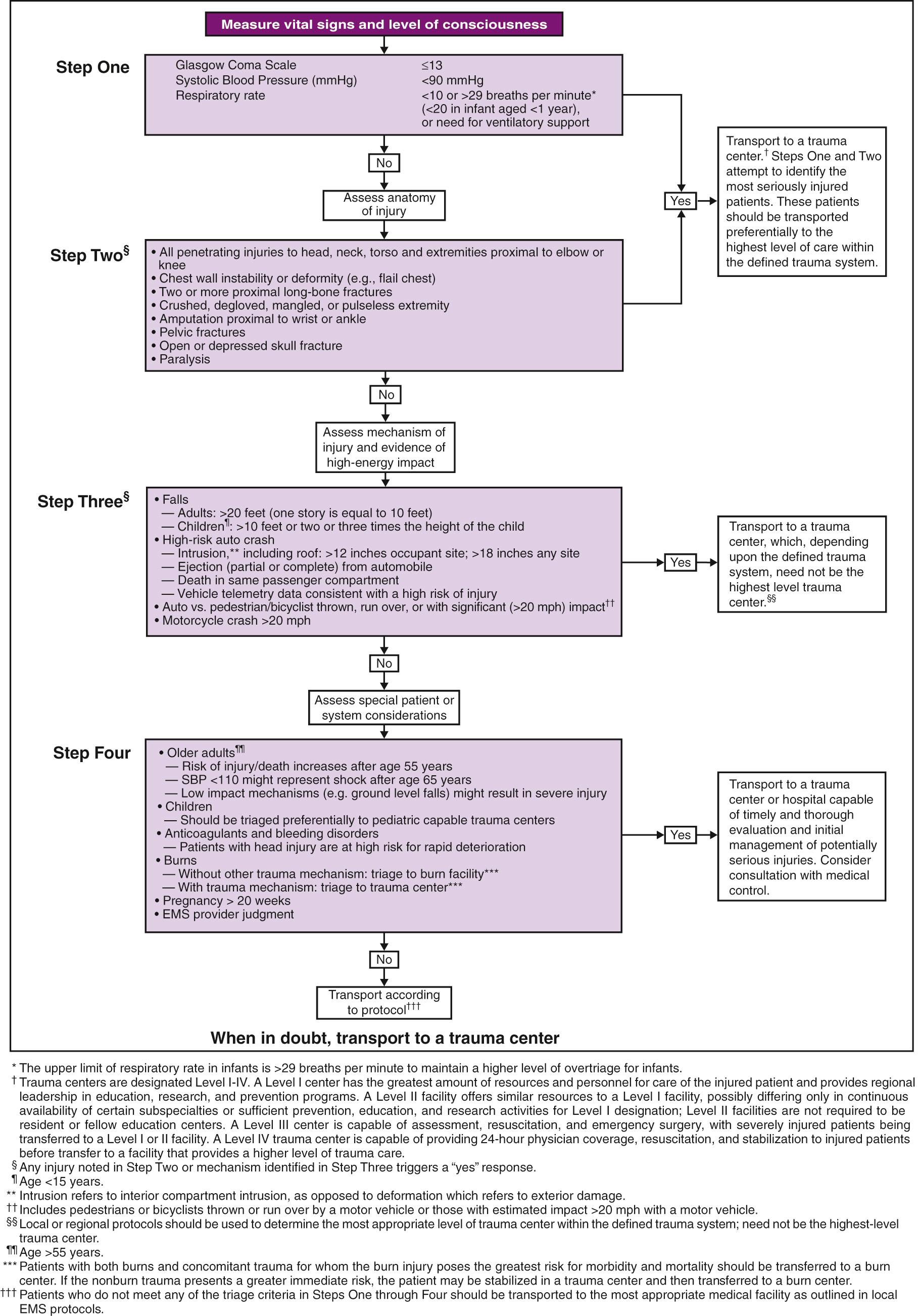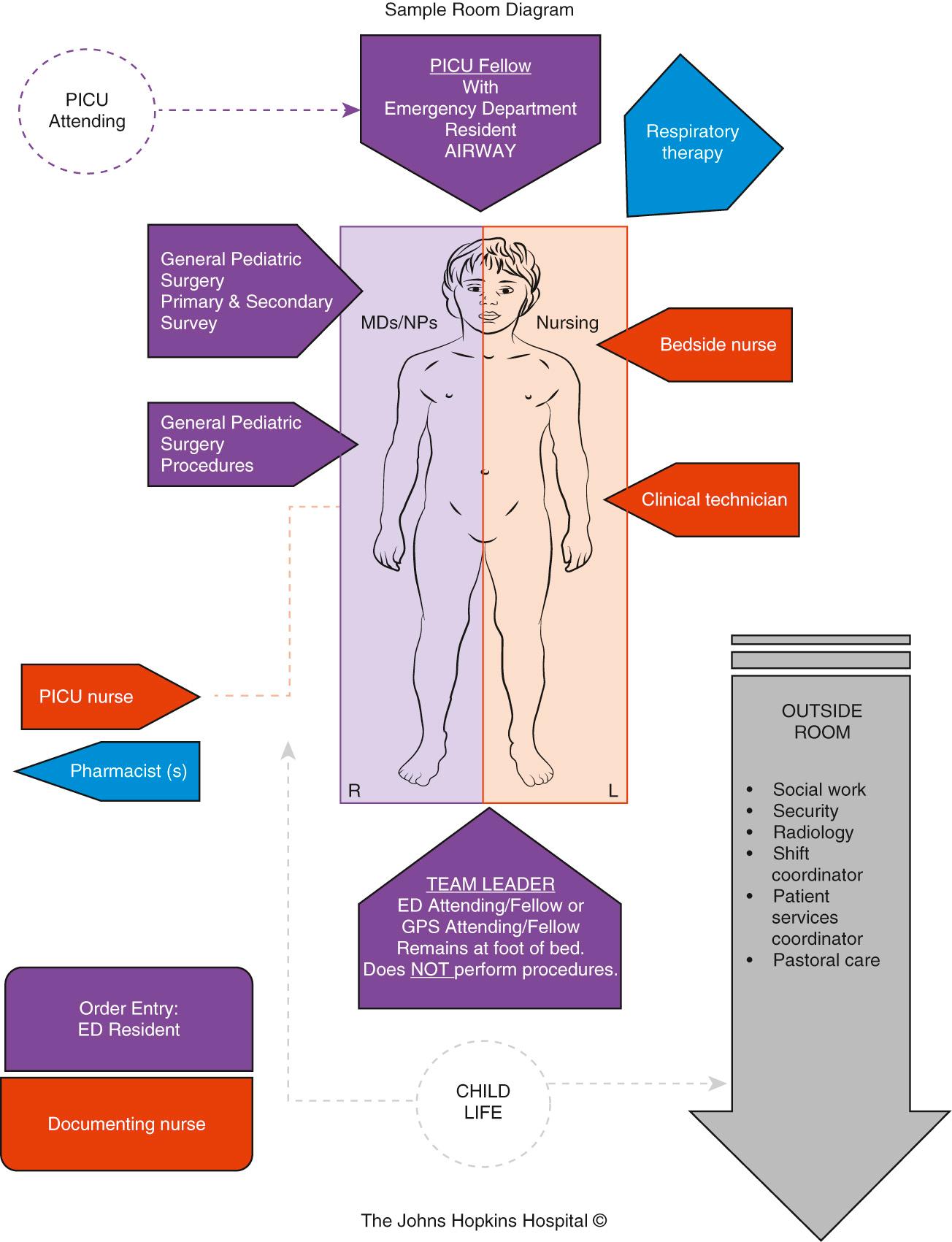Physical Address
304 North Cardinal St.
Dorchester Center, MA 02124
Injury is a leading cause of death and disability in children throughout the world (see Chapter 13 ). Deaths represent only a small fraction of the total trauma burden. Approximately 140,000 children were treated in U.S. trauma centers in 2016 for serious injury. Many survivors of trauma have permanent or temporary functional limitations. Motor vehicle–related injuries and falls rank among the top 15 causes of disability-adjusted life years in children worldwide.
Trauma is frequently classified according to the number of significantly injured body parts (≥1), the severity of injury (mild, moderate, or severe), and the mechanism of injury (blunt or penetrating). In childhood, blunt trauma predominates, accounting for the majority of injuries. In adolescence, penetrating trauma increases in frequency, accounting for approximately 15% of injuries, and penetrating trauma secondary to a firearm is associated with a high case fatality rate of 11%.
Mortality and morbidity rates have decreased in geographic regions with comprehensive, coordinated trauma systems. Treatment at designated trauma centers is associated with decreased mortality. At the scene of injury, paramedics should administer necessary advanced life support and perform triage ( Fig. 82.1 ). It is usually preferable to bypass local hospitals and rapidly transport a seriously injured child directly to a pediatric trauma center (or a trauma center with pediatric commitment). Children have lower mortality rates, lower complication rates, and less operative interventions after severe blunt trauma when they are treated in designated pediatric trauma centers or in hospitals with pediatric intensive care units.

When the receiving emergency department (ED) is notified before the child's arrival, the trauma team should also be mobilized in advance. Each member has defined tasks. A senior surgeon (surgical coordinator) or, sometimes initially, an emergency physician leads the team. Team compositions vary somewhat from hospital to hospital; Fig. 82.2 shows the model used at The Johns Hopkins Hospital Bloomberg Children's Center (Baltimore, MD). Consultants, especially neurosurgeons and orthopedic surgeons, must be promptly available; and the operating room staff should be alerted.

Physiologic status, anatomic locations, and/or mechanism of injury are used for field triage as well as to determine whether to activate the trauma team. More importance should be placed on physiologic compromise and less on mechanism of injury. Scoring scales such as the Abbreviated Injury Scale (AIS), Injury Severity Score (ISS), Pediatric Trauma Score ( Table 82.1 ), and Revised Trauma Score use these parameters to predict patient outcome. The AIS and ISS are used together. First, the AIS is used numerically to score injuries—as 1 minor, 2 moderate, 3 serious, 4 severe, 5 critical, or 6 probably lethal—in each of 6 ISS body regions: head/neck, face, thorax, abdomen and pelvic contents, extremities and bony pelvis, and external. The ISS is the sum of the squares of the highest 3 AIS region scores.
| COMPONENT | +2 | +1 | −1 |
|---|---|---|---|
| Size | ≥20 kg | 10-20 kg | <10 kg |
| Airway | Normal | Maintainable | Unmaintainable |
| Systolic BP | ≥90 mm Hg | 50-90 mm Hg | <50 mm Hg |
| CNS | Awake | Obtunded/LOC | Coma/decerebrate |
| Open wound | None | Minor | Major/penetrating |
| Skeletal | None | Closed fracture | Open/multiple fractures |
| Sum total points |
* Children with a Pediatric Trauma Score ≤6 are at increased risk of mortality as well as morbidity.
During the primary survey, the physician quickly assesses and treats any life-threatening injuries. The principal causes of death shortly after trauma are airway obstruction, respiratory insufficiency, shock from hemorrhage, and central nervous system (CNS) injury. The primary survey addresses the ABCDEs : Airway, Breathing, Circulation, neurologic Deficit, and Exposure of the patient and control of the Environment.
Optimizing oxygenation and ventilation, while protecting the cervical spine (C-spine) from potential further injury, is of paramount importance. Initially, C-spine injury should be suspected in any child sustaining multiple, blunt trauma. Although C-spine injuries occur less often in children than adults, children are at risk for such injuries because of their relatively large heads in proportion to the rest of their body, which augment flexion-extension forces, and weak neck muscles, which predispose them to ligament injuries. To prevent additional spinal injury, paramedics have traditionally been taught to immobilize the cervical (and thoracic and lumbar) spine in neutral position with a stiff collar, head blocks, tape or cloth placed across the forehead, torso, and thighs to restrain the child, and a rigid backboard.
Airway obstruction manifests as snoring, gurgling, hoarseness, stridor, and/or diminished breath sounds (even with apparently good respiratory effort). Children are more likely than adults to have airway obstruction because of their smaller oral and nasal cavities, proportionately larger tongues and more tonsillar and adenoidal tissue, higher and more anterior glottic opening, and narrower larynx and trachea. Obstruction is common in patients with severe head injuries, partly because of decreased muscle tone, which allows the tongue to fall posteriorly and occlude the airway. With trauma, obstruction can also result from fractures of the mandible or facial bones, secretions such as blood or vomit, crush injuries of the larynx or trachea, and foreign body aspiration.
If it is necessary to open the airway, a jaw thrust without head tilt is recommended. This procedure minimizes cervical spine motion. In an unconscious child, an oropharyngeal airway may be inserted to prevent posterior displacement of the mandibular tissues. A semiconscious child will gag with an oropharyngeal airway but may tolerate a nasopharyngeal airway. A nasopharyngeal airway is contraindicated when there is a possibility of cribriform plate fracture. If these maneuvers plus suctioning do not clear the airway, oral endotracheal intubation is indicated. When endotracheal intubation proves difficult, a laryngeal mask airway can be used as a temporary alternative. A laryngeal mask airway consists of a tube with an inflatable cuff that rests above the larynx and thus does not require placement of the tube into the trachea. Video-assisted laryngoscopy or the use of a bougie can also be helpful in the management of a difficult airway. Emergency cricothyrotomy is needed in <1% of trauma victims.
The physician assesses breathing by counting the respiratory rate; visualizing chest wall motion for symmetry, expansion, and accessory muscle use; and auscultating breath sounds in both axillae. Continuous waveform capnography monitoring should also be used as an adjunct; however, it is less reliable in patients with shock. In addition to looking visually for cyanosis, pulse oximetry is standard. If ventilation is inadequate, bag-valve-mask ventilation with 100% oxygen must be initiated immediately, followed by endotracheal intubation. End-expiratory carbon dioxide (CO 2 ) detectors or capnography help verify accurate tube placement.
Head trauma is the most common cause of respiratory insufficiency. An unconscious child with severe head injury may have a variety of breathing abnormalities, including Cheyne-Stokes respiration, slow irregular breaths, and apnea.
Although less common than a pulmonary contusion, tension pneumothorax and massive hemothorax are immediately life threatening ( Tables 82.2 and 82.3 ). Tension pneumothorax occurs when air accumulates under pressure in the pleural space. The adjacent lung is compacted, the mediastinum is pushed toward the opposite hemithorax, and the heart, great vessels, and contralateral lung are compressed or kinked (see Chapter 439 ). Both ventilation and cardiac output are impaired. Characteristic findings include cyanosis, tachypnea, retractions, asymmetric chest rise, contralateral tracheal deviation, diminished breath sounds on the ipsilateral (more than contralateral) side, and signs of shock. Needle thoracentesis, followed by thoracostomy tube insertion, is diagnostic and lifesaving. Hemothorax results from injury to the intercostal vessels, lungs, heart, or great vessels. When ventilation is adequate, fluid resuscitation should begin before evacuation, because a large amount of blood may drain through the chest tube, resulting in shock.
| TENSION PNEUMOTHORAX | MASSIVE HEMOTHORAX | CARDIAC TAMPONADE | |
|---|---|---|---|
| Breath sounds | Ipsilaterally decreased more than contralaterally | Ipsilaterally decreased | Normal |
| Percussion note | Hyperresonant | Dull | Normal |
| Tracheal location | Contralaterally shifted | Midline or shifted | Midline |
| Neck veins | Distended | Flat | Distended |
| Heart tones | Normal | Normal | Muffled |
One-way valve leak from the lung parenchyma or tracheobronchial tree
Lung collapse with mediastinal and tracheal shift to the side opposite the leak
Compromises venous return and decreases ventilation of the other lung
Clinically, manifests as respiratory distress, unilateral absence of breath sounds, tracheal deviation, distended neck veins, tympany to percussion of the involved side, and cyanosis
Relieve first with needle aspiration, then with chest tube drainage
Effect on ventilation depends on size
Usually caused by blunt injury resulting in multiple rib fractures
Loss of bone stability of the thoracic cage
Major disruption of synchronous chest wall motion
Mechanical ventilation and positive end-expiratory pressure required
Become a Clinical Tree membership for Full access and enjoy Unlimited articles
If you are a member. Log in here